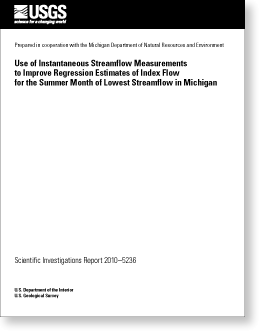Science Investigations Report 2010–5236
ABSTRACT
In Michigan, index flow Q50 is a streamflow characteristic defined as the minimum of median flows for July, August, and September. The state of Michigan uses index flow estimates to help regulate large (greater than 100,000 gallons per day) water withdrawals to prevent adverse effects on characteristic fish populations. At sites where long-term streamgages are located, index flows are computed directly from continuous streamflow records as GageQ50. In an earlier study, a multiple-regression equation was developed to estimate index flows IndxQ50 at ungaged sites. The index equation explains about 94 percent of the variability of index flows at 147 (index) streamgages by use of six explanatory variables describing soil type, aquifer transmissivity, land cover, and precipitation characteristics. This report extends the results of the previous study, by use of Monte Carlo simulations, to evaluate alternative flow estimators, DiscQ50, IntgQ50, SiteQ50, and AugmQ50. The Monte Carlo simulations treated each of the available index streamgages, in turn, as a miscellaneous site where streamflow conditions are described by one or more instantaneous measurements of flow. In the simulations, instantaneous flows were approximated by daily mean flows at the corresponding site. All estimators use information that can be obtained from instantaneous flow measurements and contemporaneous daily mean flow data from nearby long-term streamgages. The efficacy of these estimators was evaluated over a set of measurement intensities in which the number of simulated instantaneous flow measurements ranged from 1 to 100 at a site. |
For additional information contact: Part or all of this report is presented in Portable Document Format (PDF); the latest version of Adobe Reader or similar software is required to view it. Download the latest version of Adobe Reader, free of charge. |
Holtschlag, D.J., 2011, Use of instantaneous streamflow measurements to improve regression estimates of index flow for the summer month of lowest streamflow in Michigan: U.S. Geological Survey Scientific Investigations Report 2010–5236, 86 p.
Abstract
Introduction
Flow Data
Improving Regression Estimates of Index Flow by use of Instantaneous Flow Measurements
Summary and Conclusions
References Cited
Appendix 1. Tables of streamgage attributes and flow characteristics
Appendix 2. Example Matlab Code computations of index flow measurements for improving regression estimates with simulated instantaneous measurements.